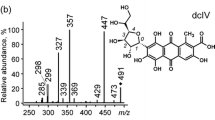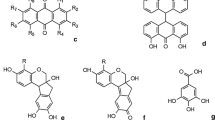Abstract
The anthraquinone components of the roots of various species of madder (Rubia spp.) have been used for millennia as red colorants in textiles, carpets and other objects. Although many species of Rubia are known, only a few of them have been used widely for dyeing. Furthermore, though nearly 70 anthraquinones have been found in Rubia species, only a few of these occur consistently at relatively high levels. Knowledge of the plant dyestuffs is helpful for establishing the location of production, production method and/or history of the dyed object. Using plant material and dyed textile fibers obtained from a number of sources, and HPLC with photodiode array and mass spectrometric detection for analysis, we have been able to identify marker anthraquinones that permit differentiation of the more common species of madder used for dyeing in Eurasia. Textiles dyed with all of the species examined contain varying amounts of purpurin, but only those dyed with Rubia akane contain large amounts of 6-hydroxyrubiadin (1,3,6-trihydroxy-2-methylanthraquinone) or its glycosides. Textiles dyed with R. tinctorum contain primarily alizarin, whereas those dyed with R. cordifolia and R. peregrina contain mostly purpurin, munjistin and pseudopurpurin, but little or no alizarin or 6-hydroxyrubiadin. The latter two species cannot reliably be distinguished from each other, however. The plants themselves often contain glycoside precursors not usually seen in the dyed materials.

The analysis, based on HPLC retention time, UV/Visible spectra and molecular mass, of ancient madder (Rubia)-dyed textile extracts can identify the species used for dyeing.





Similar content being viewed by others
References
Cardon D (2007) Natural dyes: sources, tradition, technology and science. Archetype, London, pp 107–166
Singh R, Geetanjali, Chauhan SMS (2004) 9,10-Anthraquinones and other biologically active compounds from the genus Rubia. Chem Biodivers 1(9):1241–1264. doi:10.1002/cbdv.200490088
Schweppe H (1993) Handbuch der Naturfarbstoffe. Nikol, Hamburg, pp 200–252
Schweppe H, Winter J (1997) Madder and Alizarin. In: Fitzhugh EW (ed) Artists’ pigments, a handbook of their history and characteristics, vol 3. National Gallery of Art, Washington, pp 109–142
Boldizár I, Szücs Z, Füzfai ZS, Molnár-Perl I (2006) Identification and quantification of the constituents of madder root by gas chromatography and high-performance liquid chromatography. J Chrom A 1133:259–274. doi:10.1016/j.chroma.2006.08.021
Derksen GCH, van Beek TA (2002) Rubia tinctorum L. In: Rahman A (ed) Studies in natural products chemistry, vol 26. Elsevier, Amsterdam, pp 629–684
Wouters J (1985) High performance liquid chromatography of anthraquinones: analysis of plant and insect extracts and dyed textiles. Stud Conserv 30:119–128
Mouri C, Laursen R (2011) Identification and partial characterization of C-glycosylflavone markers in Asian plant dyes using liquid chromatography–tandem mass spectrometry. J Chrom A 1218:7325–7330. doi:10.1016/j.chroma.2011.08.048
Zhang X, Laursen RA (2005) Development of mild extraction methods for the analysis of natural dyes in textiles of historical interest using LC-diode array detector-MS. Anal Chem 77:2022–2025. doi:10.1021/ac048380k
Hill R, Richter D (1936) Anthraquinone colouring matters: galiosin; rubiadin primveroside. J Chem Soc 1714–1719. doi:10.1039/JR9360001714
Derksen GCH, Naayer M, van Beek TA, Capelle A, Haaksman IK, van Doren HA, de Groot Æ (2003) Chemical and enzymatic hydrolysis of anthraquinone glycosides from madder roots. Phytochem Anal 14:137–144. doi:10.1002/pca.694
Derksen GCH, Niderländer HAG, van Beek TA (2002) Analysis of anthraquinones in Rubia tinctorum L. by liquid chromatography coupled with diode-array UV and mass spectrometric detection. J Chrom A 978:119–127. doi:10.1016/S0021-9673(02)01412-7
Ishii Y, Okamura T, Inoue T, Fukuhara K, Umemura T, Nishikawa A (2010) Chemical structure determination of DNA bases modified by active metabolites of lucidin-3-O-primeveroside. Chem Res Toxicol 23:134–141. doi:10.1021/tx900314c
Cardon D (2007) Natural dyes: sources, tradition, technology and science. Archetype, London, p 136
Cuoco G, Mathe C, Archier P, Vieillescazes C (2011) Characterization of madder and garancine in historic French red materials by liquid chromatography-photodiode array detection. J Cult Herit 12:98–104. doi:10.1016/j.culher.2010.05.005
Wouters J (2001) The dye of Rubia peregrina. I. Preliminary investigations. Dyes Hist Archaeol 16/17:145–157
Böhmer H (1998) in Das Jahrbuch der Pazyryk Gesellschaft. Band 1, Munich pp 23–27
Schweppe H (1993) Handbuch der Naturfarbstoffe. Nikol, Hamburg, p 232
Myers DK, Bean S (eds) (1994) From the land of the thunder dragon: textile arts of Bhutan. Serindia Publications, London; Peabody-Essex Museum, Salem, p 195
Hofenk de Graaff JH, van Bommel MR (2001) Dyestuff analysis of the Central Asian woolen textiles. In: Keller D, Schorta R (eds) Fabulous creatures from the desert sands. Riggisberg, Abegg-Stiftung, pp 137–148
Mallory JP, Mair V (2000) The Tarim mummies. Thames and Hudson, London
Cheng W (1992) History of textile technology of ancient China. Science Press, New York, p 99
Jagchid S, Symons VJ (1989) Peace, war and trade along the Great Wall: Nomadic-Chinese Interaction through two Millennia. Indiana University Press, Bloomington, p 28
Hill RA, Krebs RC, Verpoorte R, Wijnsma R (1986) Anthraquinones in the Rubiaceae. In: Herz W, Grisebch H, Kirby GW, Tamm H (eds) Progress in the chemistry of organic natural products, vol 49. Springer, New York, pp 77–149
Han YS, Van der Heijden R, Verpoorte R (2001) Biosynthesis of anthraquinones in cell cultures of the Rubiaceae. Plant Cell Tiss Organ Cult 67:201–220. doi:10.1023/A:1012758922713
Wouters J, Rosario-Chirinos N (1992) Dye analysis of pre-Columbian Peruvian textiles with high-performance liquid chromatography and diode-array detection. J Am Inst Conserv 31:237–255. doi:10.2307/3179495
Acknowledgments
We would like to express our gratitude to the many people who provided plant material and/or dyed textile specimens for these studies: A. Aali, B. Bigler, D. Boufford, D. Cardon, K. Corrigan, F. Elwert, K. Fukami, K. Fujikawa, I. Good, M. Kataoka, M. Mikage, B. Miller, K. Malla, H. Persson, H. Sumi, and K. Yamazaki. We wish also to acknowledge a grant from the Toyota Foundation (no. D10-R-0172) to K. Fukami that supported a portion of this work.
Author information
Authors and Affiliations
Corresponding author
Rights and permissions
About this article
Cite this article
Mouri, C., Laursen, R. Identification of anthraquinone markers for distinguishing Rubia species in madder-dyed textiles by HPLC. Microchim Acta 179, 105–113 (2012). https://doi.org/10.1007/s00604-012-0868-4
Received:
Accepted:
Published:
Issue Date:
DOI: https://doi.org/10.1007/s00604-012-0868-4




